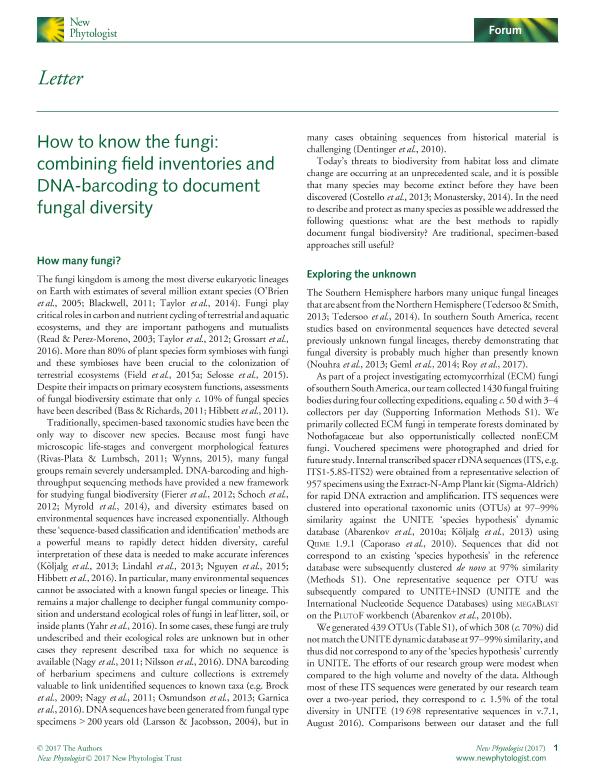Artículo
How to know the fungi: combining field inventories and DNA‐barcoding to document fungal diversity
Truong, Camille; Mujic, Alija; Healy, Rosanne; Kuhar, José Francisco ; Furci, Giuliana; Torres, Daniela Soledad
; Furci, Giuliana; Torres, Daniela Soledad ; Niskanen, Tuula; Sandoval Leiva, Pablo A.; Fernández, Natalia Verónica
; Niskanen, Tuula; Sandoval Leiva, Pablo A.; Fernández, Natalia Verónica ; Escobar, Julio Martin
; Escobar, Julio Martin ; Moretto, Alicia Susana
; Moretto, Alicia Susana ; Palfner, Götz; Pfister, Donald; Nouhra, Eduardo Ramon
; Palfner, Götz; Pfister, Donald; Nouhra, Eduardo Ramon ; Swenie, Rachel; Sanchez Garcıa, Marisol; Matheny, P. Brandon; Smith, Matthew
; Swenie, Rachel; Sanchez Garcıa, Marisol; Matheny, P. Brandon; Smith, Matthew
 ; Furci, Giuliana; Torres, Daniela Soledad
; Furci, Giuliana; Torres, Daniela Soledad ; Niskanen, Tuula; Sandoval Leiva, Pablo A.; Fernández, Natalia Verónica
; Niskanen, Tuula; Sandoval Leiva, Pablo A.; Fernández, Natalia Verónica ; Escobar, Julio Martin
; Escobar, Julio Martin ; Moretto, Alicia Susana
; Moretto, Alicia Susana ; Palfner, Götz; Pfister, Donald; Nouhra, Eduardo Ramon
; Palfner, Götz; Pfister, Donald; Nouhra, Eduardo Ramon ; Swenie, Rachel; Sanchez Garcıa, Marisol; Matheny, P. Brandon; Smith, Matthew
; Swenie, Rachel; Sanchez Garcıa, Marisol; Matheny, P. Brandon; Smith, Matthew
Fecha de publicación:
03/2017
Editorial:
Wiley Blackwell Publishing, Inc
Revista:
New Phytologist
ISSN:
0028-646X
e-ISSN:
1469-8137
Idioma:
Inglés
Tipo de recurso:
Artículo publicado
Clasificación temática:
Resumen
The fungi kingdom is among the most diverse eukaryotic lineages on Earth with estimates of several million extant species (O´Brien et al., 2005; Blackwell, 2011; Taylor et al., 2014). Fungi play critical roles in carbon and nutrient cycling of terrestrial and aquatic ecosystems, and they are important pathogens and mutualists (Read & Perez-Moreno, 2003; Taylor et al., 2012; Grossart et al., 2016). More than 80% of plant species form symbioses with fungi and these symbioses have been crucial to the colonization of terrestrial ecosystems (Field et al., 2015a; Selosse et al., 2015). Despite their impacts on primary ecosystem functions, assessments of fungal biodiversity estimate that only c. 10% of fungal species have been described (Bass & Richards, 2011; Hibbett et al., 2011).
Palabras clave:
Mycorrhiza
,
Barcoding
,
Morphotipe
,
Metagenomics
Archivos asociados
Licencia
Identificadores
Colecciones
Articulos(IMBIV)
Articulos de INST.MULTIDISCIPL.DE BIOLOGIA VEGETAL (P)
Articulos de INST.MULTIDISCIPL.DE BIOLOGIA VEGETAL (P)
Articulos(SEDE CENTRAL)
Articulos de SEDE CENTRAL
Articulos de SEDE CENTRAL
Citación
Truong, Camille; Mujic, Alija; Healy, Rosanne; Kuhar, José Francisco; Furci, Giuliana; et al.; How to know the fungi: combining field inventories and DNA‐barcoding to document fungal diversity; Wiley Blackwell Publishing, Inc; New Phytologist; 214; 3; 3-2017; 913-919
Compartir
Altmétricas



